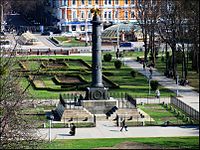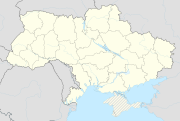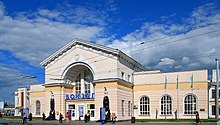Poltava
| Poltava | ||
| Полтава | ||

|
|
|
| Basic data | ||
|---|---|---|
| Oblast : | Poltava Oblast | |
| Rajon : | District-free city | |
| Height : | 132 m | |
| Area : | 103.5 km² | |
| Residents : | 292,700 (January 1, 2011) | |
| Population density : | 2,828 inhabitants per km² | |
| Postcodes : | 36000-36499 | |
| Area code : | +380 532 | |
| Geographic location : | 49 ° 35 ' N , 34 ° 34' E | |
| KOATUU : | 5310100000 | |
| Administrative structure : | 3 city racks | |
| Mayor : | Oleksandr Shamota | |
| Address: | вул. Жовтнева 36 36000 м. Полтава |
|
| Website : | http://www.rada-poltava.gov.ua/ | |
| Statistical information | ||
|
|
||
Poltava ( Ukrainian and Russian Полтава ) is a city in central Ukraine on the river Vorskla with about 300,000 inhabitants. It is the center of the oblast of the same name and the administrative seat of the Rajon of the same name . The city is located about 350 km south-east of the Ukrainian capital Kiev and is divided into the Stadtrajone Rajon Kiev , Rajon Podil and Rajon Shevchenko .
history

The area around today's city was already populated in the Middle and Neolithic. Remnants of the Tripolje culture (6000 to 1000 BC) were found nearby . In Bulgarian writings from the 7th century there is talk of the city of Baltawar on the Worskla, a document of the Kievan Rus from 1174 reports on the city of Ltava, in other sources the name Oltava can be found. It is not certain whether the place was permanently settled during the Mongol period (13th-14th centuries). In 1430 Poltava is mentioned for the first time with its current name as a place of the Lithuanian principality , which later entered into a union with Poland under Polish hegemony. In 1641 the Polish-Lithuanian state granted Poltava city rights. At that time, 812 people lived in the city and there were 11 mill wheels.
During the Khmelnytskyi uprising (1648-1658) the city was an important base for the Zaporozhian Cossacks . During this time the Exaltation of the Cross Monastery was built. From 1668 the city came more and more under the influence of Russia, even if the Cossacks were initially granted extensive rights of autonomy. In 1709 one of the greatest battles of the Great Northern War took place near the city with the Battle of Poltava . After the Russian victory, the city became part of Russia in 1713 . In the 18th century, the Uspensky Cathedral (1705-1801) was built, of which only the free-standing bell tower survived the Soviet era ; the nave was destroyed in 1934. It was rebuilt next to the bell tower by 2004, based on the historical model.
From 1803 the city was the center of the Russian governorate Poltava . At this time, the planned redesign of the inner city on the occasion of the 100th anniversary of the Russian victory began. The round square with its classicist buildings is particularly impressive. From 1816 Nikolai Grigoryevich Repnin-Volkonsky was governor of Poltava.
By the end of the 19th century, the city had grown to 53,703 inhabitants. The largest ethnic group at that time was made up of the Ukrainians (56.0%), alongside larger Russian (20.6%) and Jewish population groups (19.9%). The first Jews had settled in the early 19th century; their number increased significantly to 11,046 by 1897. 2% of the residents were Poles , 0.5% German . In the course of the Soviet urbanization efforts, the population grew rapidly in the 20th century, although the city suffered heavy losses in the Russian Civil War and World War II . Between 1918 and 1920 there were several pogroms against Jewish residents, who in 1939 made up 12,860 people, 9.9 percent of the population.
Poltava, which was under German occupation from September 19, 1941 ( Reichskommissariat Ukraine ), was the headquarters of the German Army Group South , which was to conquer Stalingrad and the Caucasus region. Many Jews fled the German occupation, so that the compulsory registration in September 1941 resulted in around 5,000 and in October 1941 3,500 Jews in the city who were exposed to the programmatic terror by the Nazi authorities. Most of them were killed in two murders in late September and late November 1941. On September 23, 1943, the Red Army retook Poltava during the Battle of the Dnieper . In the city there was a prisoner of war camp 136 for German prisoners of war of the Second World War . Seriously ill people were cared for in the prisoner-of-war hospital in 2071 . In the last two years of the war, the Poltava military airport was one of the three bases in the European part of the Soviet Union that the United States Army Air Forces used for their B-17 bombers (see Operation Frantic ). On June 22, 1944, a German air raid destroyed 43 of the B-17s and damaged 26 others. American pilots then accused the Soviet side of not having adequately secured the base.
Even during the transition crisis after the end of the Soviet Union, the city was able to continue its growth. Poltava is now predominantly inhabited by Ukrainians (2001: 87.7%) and Russians (10.6%), Belarusians (0.2%) and Armenians (0.2%) form smaller minorities.
politics
Since 1988 there has been a town partnership with the towns of Filderstadt , Leinfelden-Echterdingen and Ostfildern in Germany.
Infrastructure and economy
In Poltava there is an agricultural academy, an educational, an industrial, an economic university and a linguistic university. The most important economic factor in the city is mechanical engineering , along with the food and light industries . Poltava is an important transportation hub in eastern central Ukraine. From here roads lead to Kiev ( E 40 ), Kharkiv (E 40), Kremenchuk ( E 577 ) and Sumy ( R -17). Rail connections exist in the direction of Kiev , Kharkiv, Kremenchuk and Rostov (via Krasnohrad ). The Kiev-Kharkiv line has been fully electrified since 2008. Poltava also has an airport located seven kilometers west of the city on the E 40 (IATA code: PLV, ICAO code: UKHP).
Inner-city traffic is based on a network with 11 trolleybus lines and 65 bus lines (as of 2010).
Sports
The municipal football club Vorskla Poltava won the Ukrainian Football Cup in 2009 and qualified for the UEFA Europa League in 2011 and 2018 .
sons and daughters of the town
Eponyms
In 1986 the asteroid (2983) Poltava was named after the city.
literature
AV Kudryc'kyj (ed.), Poltavščyna. Encyclop. slovnyk. Kiev 1992.
Web links
supporting documents
- ↑ http://www.rada-poltava.gov.ua/city/
- ↑ Ada Anders: Travel Guide Ukraine. Dumont, Cologne 2012, p. 361.
- ↑ a b c Poltava. In: The Untold Story. The Murder Sites of the Jews in the Occupied Territories of the Former USSR. Jad Vaschem , 2016 (English).
- ↑ Erich Maschke (ed.): On the history of the German prisoners of war of the Second World War. Ernst and Werner Gieseking, Bielefeld 1962–1977.
- ^ The Poltava Debacle. In: Air Force Magazine , March 2011.
- ^ Jean Folkerts: Report on the Russians: The Controversy Surrounding William Lindsay White's 1945 Account of Russia. In: American Journalism. Vol. 32, 2015, No. 3, pp. 307-328, doi : 10.1080 / 08821127.2015.1064684 , here p. 324 f.





